|
Politică și societate
Just how tabloidized is tabloid press?
Personalization, sensationalism and negativism in the
coverage
of the Romanian presidential elections, 2009
FLORINA CREŢU1
[National School of
Political and Administrative Science]
Abstract:
The problematics of the public sphere, as
firstly outlined by Habermas, has triggered many
reflections concerning the metamorphoses in
political communication. In this regard, one of the
most prominent phenomenona approached in the
established literature of media transformations
refers to that of tabloidization. According to
different scholars, not only are journalistic
discourses heading towards a tabloidized style of
reporting, but also these practices tend to hinder
the creation of public spheres. The present study
wishes to understand the relation between these two
assertions and empirically, to test their validity
on the Romanian tabloid media. Particularly, it aims
at exploring whether the tabloids’ news coverage of
the last presidential elections meets the general
standards of what is called „tabloidization”; and if
so, how this may affect our definitions of the
public sphere.
Keywords: trends in political communication;
personalization and sensationalism of tabloid
discourses; negative reporting; Romanian tabloid
media
1. Introduction: the public sphere and the page 5
syndrome
Habermas’ first work on the public sphere and „the
commodification” of the public realm2
has initiated different perspectives, concerning both the meanings of this
concept3 and the transformations
it signaled4.
The commercialization of political communication, as this process has broadly
been coined by scholars, has been the subject of ample research and was given
many names in the established literature. From „Americanization”5
to „mediacracy”6 and
„tabloidization”7academics have
tried to designate, one way or another, the changes occurring in the media
coverage of political events. Generally, they referred to an allegedly growing
journalistic style that values sensationalist discourses, a particular focus on
the personality of politicians, as opposed to policies or political programs,
and a negative trend of reporting. Supposedly, this would result in citizens’
apathy towards politics8, a
general „dumbing down”9 and the
dissolution of certain democratic values, as we know them.
The overwhelmingly pessimistic view over these changes in political
communication has developed to the extent where different journalistic genres
were classified as being or not part of the public sphere10.
This was particularly the case of tabloid and tabloidized media, considered idle
for everyday opinion formation, through their playful and brief style of
reporting11. We find this type
of approach not only sterile in our understanding of media dynamics, but also
narrow, in what regards the definitions of tabloidization and the public sphere,
generally. How can these concepts be defined? Is there a general
trend of tabloidization? And if so, does this necessarily involve a
dissolution of the public sphere? These questions will represent the
landmarks of this paper. However, answering them requires a deeper understanding
of the broader context they stem from, that of mass-media commercialization and
its associated processes. Thus, the next section of this study will try to
address this issue.
2. The mediated public sphere: structural transformations in political
communication
The public realm’s colonization by the entertainment industry
represented one of the first statements that defined both the transformations
occurring in the public sphere and the eloignment from its normative ideal.
Thus, originally, the public sphere was understood as „the sphere of the
individuals that gather as a public”12,
a rational, deliberative space of engagement between citizens and public
authorities, designed to reach the common good. According to Habermas13,
the current public sphere, represented by political journalism, lacks a certain
sense of rationality, sobriety, objectivity and deliberative potential.
Generally, this approach of the evolution of political communication has
generated endless debates concerning the media’s role in contemporary
democracies, and especially that of television. Although the various points of
view expressed in this regard stress on distinct perspectives, they converge in
the following postulate: because the media represent our main sources of
information and interaction with the political world, they represent the public
sphere. In this context, they are seen as placing themselves in the center
of political processes, shaping the public agenda14
and even the practices of political institutions15,
generating what is called a „mediated public sphere”16.
Thus, some authors have taken the Habermasian stand, affirming that by using
sensationalist discourses, influenced by popular culture elements, the quality
of modern journalism has seriously diminished17.
Allegedly, the result of this would be the decline of civic involvement18
and the rise of political cynism19.
Before we proceed at discussing the effects of the „new political
communication” upon citizens, we deem necessary to highlight the way
commercialization is understood in the light of the abovementioned theories.
Thus, this phenomenon is considered a product of two different processes:
first of all, under the pressures of market imperatives, the birth and
development of private televisions, media instances have started to include in
their programming an increasing number of entertainment shows20.
That is why various scholars have ascertained the emergence of journalistic
genres tributary to popular culture like talk-shows, lifestyle magazine
television and those pursuing private experiences, testimonials. In this
context, authors like Adorno, Horkheimer21
and Mehl22 speak of a culture
of commodification and emotions that would lead to a dissolution of the
boundaries between the public and the private.
Secondly, different formats of political communication have started to borrow
entertainment elements, generating what is called infotainment23.
As Van Santen has shown, this term has been interchangeably used with that of
„tabloidization”24. The
dominant outlook over this trend is that topics such as fashion, sporting events
and sensationalist facts dominate the media agenda, to the detriment of
political issues. Furthermore, it is deemed that throughout electoral campaigns,
political candidates have started to conform to this media logic, promoting
their image in certain genres considered until recently non-political, such as
talk-shows or in various informal contexts (shopping, playing the saxophone,
dancing, etc.)25. This process
is referred as the depolitization of political communication26.
One of the principles of this strand of literature is that modern press
provides over-simplified information to the public regarding politics (the so
called „dumbing-down” effect)27,
stressing rather on the visual component of political communication and
generating what is currently called image-bite politics28.
In other words, the idea underlining this approach is that the political
information we ordinarily receive is reduced to a fast collage of candidate’s
pictures.
Moreover, media coverage of electoral campaigns is said to be increasingly
focused on designating winners and losers, engendering a pretended
horse-race coverage29.
Last but not least, by stressing on the personal lives of politicians and
weighing against their political programs, mediated discourses embolden the
personalization of politics30.
All these phenomena have been broadly ascribed to a trend of Americanization
in political communication31.
Consequently, the various transformations occurring in political journalism have
been associated to terms such as „mediacracy”, „spectatorship” or „public
relations democracy”32.
Thus, the view underlined by this perspective is the following: the mediated
public sphere represents a space of journalistic problematization that should
cultivate a rational outlook over political realities, in the detriment of an
emotional or a playful one. Supposedly, it should also value a certain formalism
in representing the political world, by stressing on its informational content,
residing in punctual data about legislative measures and electoral platforms.
Thus, one of the standards of political journalism is deemed as making citizens
more interested and informed concerning politics. Otherwise, the possibility of
fostering an authentic mediated public sphere is seen as questionable, and the
only reflex it may generate among citizens is considered to be cynism or
consumerism33.
Obviously, this evaluation of the metamorphoses in political communication has
been perceived by many academics as quasi-fatalist and sterile as regards to
understanding these processes34.
First and foremost, due to the particularities of each media culture, one cannot
speak of a common degree of commercialization of public spheres. From this
perspective, in his study of the television programming during the electoral
campaign in 1994, Brants concluded that the proportion between information-based
shows and entertainment ones was somewhat balanced35.
Another finding of his research was that throughout the campaign, the candidates
turned rather to informative genres such as newscast and current affairs, unlike
the tendency described by other studies.
Hence, analyzing the changes occurring in political communication requires a
more nuanced interpretation of the commercialization phenomenon, considering
also the different cultural variables at play. From this reason, the various
trends highlighted so far have been explored rather as research hypotheses in
different intercultural studies36.
As for the effects of this type of political journalism, various authors have
expressed their disagreement about its’ negative influence on everyday political
involvement37. Drawing on the
idea that the changes occurring in political communication also imply both a
different way of engaging in the public life and of understanding participation
itself; they argue for a definition of this concept based on citizens’
discursive activity, interest, attitudes and meaning-making processes,
engendered by watching political shows.
Thus, through their symbiosis with elements of popular culture, genres
containing entertainment elements are seen as having the potential to stimulate
audiences’ interest, who otherwise would reject political information38;
to reduce the social distance between politicians and the electorate39;
inspirit citizen talk40 and
various reflections concerning politics41.
Still, the strength of these effects varies from one public to another,
according to different socio-demographic variables, media consumption patterns
and political interests42.
Furthermore, by using a playful or even ironic or emotional approach, media
discourses may provide their publics another opportunity to critically position
themselves toward communicational contents43
and may represent forms of resistance against dominant social ideologies44.
From this perspective, the mediated public sphere is perceived as a cultural
sphere45, and represents „the
articulation of politics, public and personal, as a contested terrain through
affective (aesthetic and emotional) modes of communication46”.
Thence, it embeds popular culture’s and entertainment’s various forms of
manifestation, that provide for a space of reflection both regarding the inner
and outer world; allow for a certain sense of identification (like in the case
of soap-opera characters and their public) and the dialogue with our surrounding
ones.
Thus, the multiple transformations in political communication are understood
and evaluated very distinctly in the established literature. Some views have
signaled the existence of a pseudo-public sphere, of the political journalism
that values emotions in the detriment of rational reflection, the „private” as
opposed to the public and images instead of information. Others have highlighted
the emergence of a cultural public sphere that celebrates particularly these
elements, and whose manifestations contribute to the reconsolidation of the way
in which we understand political participation and even politics nowadays.
Consequently, the different tendencies of „aestheticization”47
and „emotionalization”48 in
the public sphere may have distinct effects, that go beyond the classical
interpretation paradigms of some concepts such as political knowledge.
3. Tabloidisation in the public sphere: drawing the conceptual
framework
As highlighted in the previous part of this paper, the
commercialization phenomenon has been associated with different processes and
designations. Among these, the issue of tabloidization stands as one of the most
prominent, due to its all-encompassing conceptual nature. Thus, this particular
notion is often connected with all of the abovementioned transformations in
political communication, such as depolitization, sensationalism,
personalization, horse-race coverage or focus on popular culture elements49.
Hence, it has reached a certain conceptual ambiguity, consolidated also by its
frequent association with broad terms such as „politics as entertainment”50
and its interchangeable use with that of infotainment51.
Nonetheless, some themes remain consistent, which will the subject of our
personal understanding of the concept.
In the established literature, there seems to be a certain assent regarding
the fact that tabloidization is a product of one or more of the following
dimension: a negative reporting of politicians, meant to attract the public’s
attention52; a focus on
sensationalist, entertainment-based discourses illustrating unusual events from
the political world53; a
particular emphasis on candidates’ private lives or personal character, as
opposed to public policies or electoral platforms54.
Furthermore, this type of focus on the private persona is also
illustrated by the increasing use of visuals to the detriment of informational
content55.
Thus, tabloidization is deemed as the cause of trends such as negative
coverage (or negativism), sensationalism and
personalization (or individualization) in political communication.
Furthermore, it is perceived as an expanding phenomenon, threatening the quality
of political journalism, the integrity of public culture, political involvement
and the health of democratic processes, generally56.
The pessimistic approach over this alleged orientation of mediated discourses
raises a number of questions: Is the nature of these effects indisputable?
Or, in other words, do they necessarily imply a decline of public
participation and interest in political affairs?
Although throughout the literature the connotations of tabloidization remain
mostly negative, some academics have argued for a more open-ended perspective
over this concept. Instead of referring to the benefits of classical journalism,
as a terrain of the authentic public sphere, different authors claim that, in
fact, tabloid media may represent an alternative, subversive public sphere57.
The emphasis laid on private experiences could represent the proof of more
„deeper cultural concerns”58;
their playful style of reporting and topics could be a form of challenging
dominant ideologies59 and a
way to achieve „a greater imaginative proximity to the lifeworld of the
audience”60.
Whatever the angle we might chose to adopt in evaluating this phenomenon, its
evaluation requires firstly that we investigate its degree of prominence in
certain media contexts. Otherwise, we might be evaluating a binary, distorted
picture of reality that is less grounded in our everyday media landscape. In
other words: Is tabloidization a rising process, as presumed by some61?
Like Esser62, we argue that
any answer to this question will need to take into account the different
cultural variables at play, such as the media culture within which journalistic
discourses unfold and the organizational particularities of each media
institution. Thus, one of the assumptions that will guide the forthcoming
empirical undertaking is that each media landscape is marked by different
degrees of tabloidization, if the presence of such a trend is observed.
So far, this phenomenon has been the subject of consistent research carried
out in the United States63,
Western Europe64, different
studies in China65 and The
Third World66. However,
studies in commercialization and, particularly, tabloidization in Central and
Eastern Europe remain to a certain extent scarce, being limited to a small
number of studies67.
Particularly in the case of emerging democracies in East Central Europe,
where private media institutions have developed later than those in the West,
the patterns of what one might call „tabloidization” could be less prominent.
This assumption is also justified by the views according to which, unlike the
American media outlets, some European media institutions have shown a certain
„resistance” to commercialization68.
One of the peculiarities in the study of the tabloidization hypothesis is
that it has mostly been explored by analyzing the tone and narratives of
„quality”, televised journalism69,
and to a lesser extent the style of tabloids themselves70.
Thence, paradoxically, its implicit premises have somewhat been taken for
granted in the case of „yellow journalism”. We contend that analyzing the
degree of tabloidization in a certain media culture should also
consider this aspect, as it would provide for richer, culturally valid
interpretations of this concept. For example, tabloids in Bulgaria seem to
focus on public issues, whereas the „quality” media are deemed as growing
sources of personal, sensationalist narratives71.
Hence, the idea of tabloidization may need different tinges and ways of
designating it.
Having in mind also the hypothesis of commercialization resistance in Europe72
and the potential variability of tabloidization in the Eastern bloc, this
research will pursue the following question: Is tabloid press nowadays
strongly tabloidized? Answering this question requires that we underscore
our empirical focus and personal interpretation of the phenomenon, which is what
the next section will highlight.
4. Methodological benchmarks
As previously outlined, very little research has examined the
tabloidization hypothesis in Eastern Europe. Particularly in the Romanian media
landscape, where this question has become more prominent in the last years73,
only one study has approached this particular phenomenon74.
However, it considers only the style of televised, televised sports news. Thus,
Romanian tabloids’ degree of tabloidization remains an unresearched topic.
The subject of this empirical demarche is represented by the coverage of the
last Romanian presidential campaign, in 2009. This choice was founded not only
by the postulate that electoral campaigns are increasingly tabloidized75,
but also by the fact that this particular political moment has been highly
controversial. Thus, in this campaign the acts of violence between various
groups of party members have held the news agenda for some time76;
verbal attacks of some political leaders have been often broadcasted; current
president and candidate for the position, Traian Băsescu, has been accused of
hitting a child during an electoral meeting; and the party supporting him became
famous after using in their promoting strategy local oriental songs (“manele”)
with a strongly negative reputation in the mainstream intelligentsia. Last but
not least, Băsescu’s mother suffered a surgical intervention for breast cancer,
and his daughter was said to soon announce her wedding77.
Having this type of issues on the media agenda of the 2009 campaign, we
expected that the local tabloids exploited some of them more than classical
political topics (such as electoral programmes or current internal issues).
Thus, one of the hypotheses of this research was that in these
particular circumstances, the tabloids’ coverage of the 2009 campaign might
have been the subject of a high degree of tabloidization. Before we proceed
with outlining our personal understanding of the concept and how such an
assumption could be tested, we will further detail the focus of this empirical
study.
Because Traian Băsescu, as current president at that time, and both his party
and family were frequently mentioned in the media discourses of the last
campaign, their portrayal in the tabloid press will constitute the center of our
research. By using the content analysis of references in online articles in
the period starting from the pre-campaign to the elections; we tried to
explore the extent to which the tabloids’ coverage of these actors was
marked by negativism, personalization and sensationalism. A special
emphasis was laid on how this particular candidate was illustrated in connection
to his family, party members, campaign events and issues of the current
government.
By searching for the key-words „Traian Băsescu” and „PD-L” (the supporting
Democrat-Liberal party) in the archives of the three most visited online
tabloids in 2009, we first tried to explore the main themes associated to this
candidate. The identities of these papers and the reasons that lead to their
choice will be further exposed below. Thus, in the period between October 1st (2
weeks before the official beginning of the electoral campaign) and December 5th
(the end of the campaign), we identified 394 articles corresponding to our
criteria.
Because the period of the electoral campaign was marked by a number of
outstanding events; such as the economic crisis, the cut-backs in public
functionaries’ wages, union strikes and political conflicts, they appeared in
the coverage of Traian Băsescu, as current president.
Overall, the main themes associated to this candidate were excerpted
inductively and designated as follows: deficits of the present government; the
candidacy of Băsescu and campaign events carried out by his party; his family;
the electoral debates; and the alleged aggression of a child. The first meaning
cluster (“deficits of the present government”), represented a resulting category
of 4 sub-themes, which were identified as: political conflicts or political
crisis; strikes, public functionaries’ wage reduction or economical crisis;
economical and political crisis; accusations of corruption. Thus, these themes
were coded in SPSS (Statistical Package for the Social Sciences) and their
prominence was assessed by means of frequency measurements and crosstabulations.
As the research understood tabloidization as a product of personalization,
sensationalism and negativism, we tried to explore the degree to which each of
these processes exist in the tabloids’ coverage of Traian Băsescu. Thus, our
underlining hypotheses interpreted these concepts as follows:
RH1. If the references concerning Băsescu’s
allegedly hitting of a child outnumber those concerning
his campaign events, candidature or presidential position (deficits of the
government), than the tabloids are a subject of a high degree of
sensationalism.
Thus, the assessment of this hypothesis considered only the period in which
this particular event occurred; and is based on the often-mentioned postulate
according to which tabloid formats favor spectacular events to the detriment of
public issues or the electoral process itself78.
RH2. If the frequency of references
concerning the candidate’s family is higher than that of the mentions
regarding his image as a candidate (campaign events) or as the
president (issues of the government), then we can speak of a high degree of
personalization. The assumption is also confirmed if most of the articles
contain pictures of the candidate.
The formulation of this premise envisaged the plea according to which
campaigns in the age of tabloidization focus extensively on the personal lives
of politicians and on the visuals portraying these individuals79.
RH3. The presence of negativism in the tabloids’
coverage of Băsescu is confirmed if the overall tone of the most articles is
unfavorable concerning: him as a candidate (candidacy and campaign events; in
the televised debates); as the person potentially hitting the child; his family;
his image as the current president (deficits of current government).
This hypothesis was built considering not only the alleged negative trend in
the coverage of politicians80,
but also the fact that some members of this candidate’s family have a rather
unfavorable image in the Romanian landscape. Thus, his youngest daughter was
accused of unrightfully occupying a high a position in a local private company,
earning an unusual high income for it81
and owing her political career to Traian Băsescu. Furthermore, the
abovementioned inference took into consideration the fact that the political and
social events happening before and throughout the campaign were most likely to
be attributed to the president.
The sheets subject to our analysis were chosen according the highest ranked
tabloids as number of visualizations in October and November, 200982.
Thus, Libertatea („Freedom”) occupied the first position, Cancan was the second
most viewed and Click represented the third. However, as Click did not have a
database of its previous articles, we proceeded to the next ranked tabloid as
number of displays, Showbiz.ro. Because this sheet also did not own a personal
archive of articles, we used the one provided by its host website and brand
owner, Apropo.ro.
Naturally, because any media institution has a distinct broadcasting identity,
underlining values and ownership, our methodological undertaking also
acknowledged the particularities of each online tabloid. Thus, the aforesaid
hypotheses were tested also on every one of these papers, in order to have a
clearer view over our findings.
5. Findings of the research
5.1. Sensationalism
In what concerns our first hypothesis, that of sensationalism understood as
the tabloids’ focus on Băsescu’s alleged violence act, it proved to be false.
The event started to be mentioned as of November 27th until December 5th and in
this time range it had only 22 references of the total 66 related to this
politician (SD=0.63). Consequently, its degree of coverage was lower than that
of the candidate’s campaign events and presidential image, associated with
various deficits of the government (fig.1).
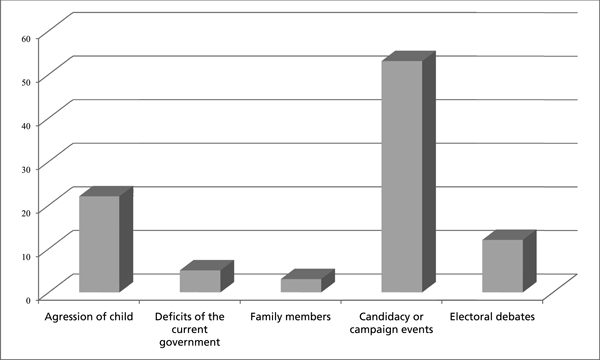
Fig.1. Overall distribution of
themes associated to Traian Băsescu, November 27th-December 5th
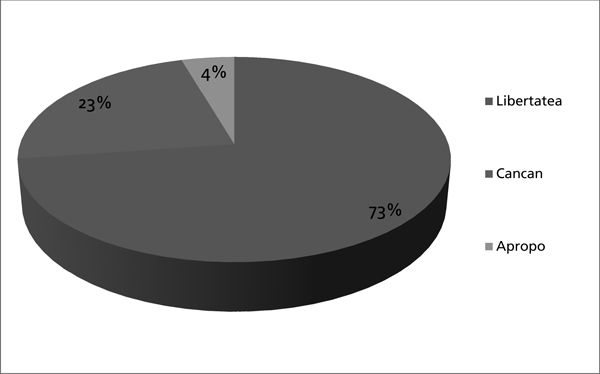
Fig.2. Distribution of references
within each tabloid concerning Băsescu’s act of violence
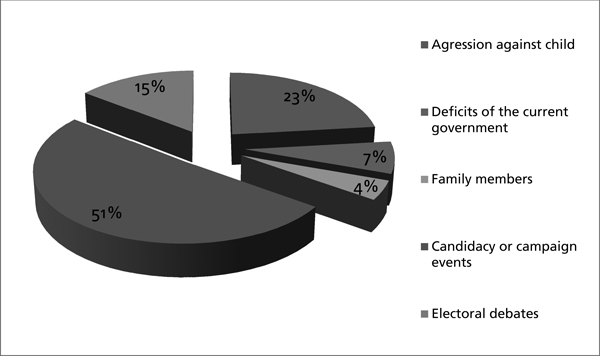
Fig.3. Libertatea: distribution of
themes associated to Traian Băsescu, November 27th-December 5th
Nonetheless, some of the campaign events themselves might have represented a
source of sensationalism, since they illustrated the clashes between different
party members, the oriental songs used for promoting Băsescu and the various
attacks addressed to this candidate. Still, in the abovementioned time range,
this category also included news referring to the opposition’s plans for the new
government and the incumbent’s course of action if he lost the election. Thus,
overall, the hypothesis according to which Băsescu’s coverage was marked by a
high degree of sensationalism, turned to be incorrect. However, its evaluation
requires that we also consider how each of the tabloids reported this event.
As figure 2 shows, the sheet that mentioned it most frequently was Libertatea,
followed by Cancan and Apropo (x2(6, N = 66) = 1.386, p < .05). This
particular sheet dedicated only 34,8% of its total references to Traian Băsescu
in this time range concerning his alleged aggression of a child (N=46; SD=0.68).
The majority of the articles focused on the campaign events, electoral debates,
deficits of the current government and family members, as illustrated in figure
3.
As for the other two online sheets, Cancan dedicated to this subject 29.4% of
its total references (N=17; SD=0.47) and Apropo, 33.4% (N=3; SD= 0.57). Both
followed the overall theme distribution as Libertatea, but without mentioning
any facts or opinions concerning Băsescu’s family.
Hence, our hypothesis regarding the presence of sensationalism in the
tabloids’ coverage of this candidate was invalidated. Most of their references
approached Traian Băsescu’s campaign events, and not his alleged act of
violence. This trend was also confirmed in the case of each tabloid. Although
the references concerning this potential aggression outnumbered those
illustrating various deficits of the government (the economic crisis, the
cut-backs in public functionaries’ wages, union strikes, political conflicts,
accusations of corruption); we considered it a result of the long period in
which these political and social events had been highly broadcasted. Thus, since
their frequency had already diminished by the time this new controversial issue
appeared, we did not consider this finding relevant to our analysis.
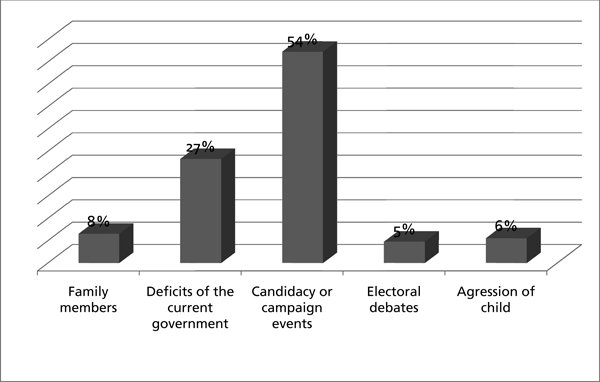
Fig.4. Overall distribution of
references of Traian Băsescu, October 1st – December 5th
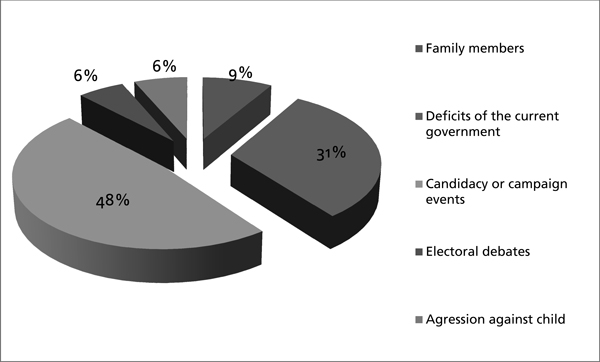
Fig.5. Libertatea: distribution of
themes associated to Traian Băsescu, October 1st – December 5th
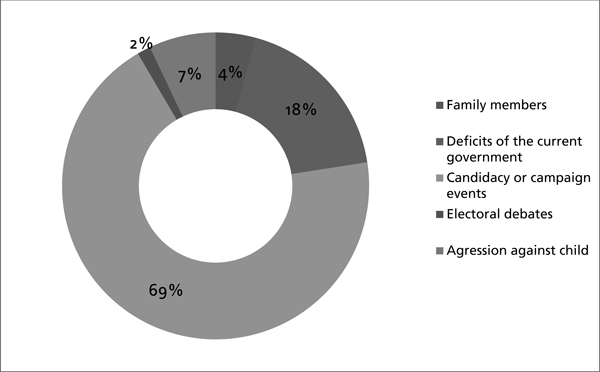
Fig.6. Cancan: distribution of
themes associated to Traian Băsescu, October 1st – December 5th
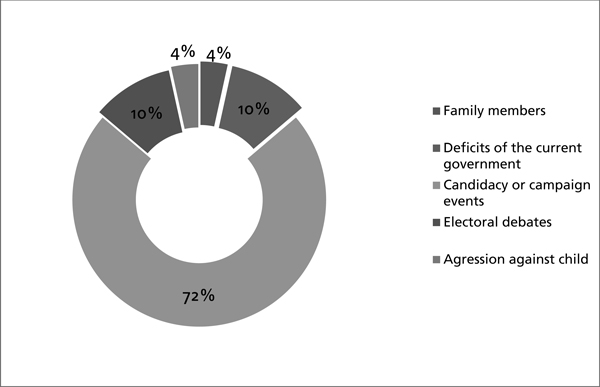
Fig.7. Apropo: distribution of
themes associated to Traian Băsescu, October 1st – December 5th
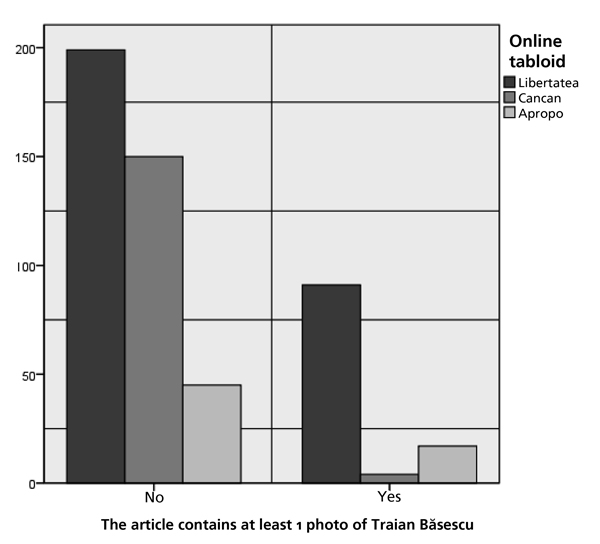
Fig. 8. Presence of images
illustrating Traian Băsescu in each of the three tabloids
5.2. Personalization
The second assumption of our empirical research was that if the frequency of
references concerning the candidate’s family is higher than that of the mentions
regarding his image as a candidate (campaign events) or as the president (issues
of the government); then one can speak of a high degree of personalization in
the tabloid press.
By exploring the candidate’s associations with the categories specified in the
methodological section of this paper, we found that overall, this hypothesis
does not confirm. As shown below, the references about Băsescu’s family amounted
less than those illustrating campaign events or deficits of the government
(N=394). Because their proportion was very low in the overall coverage of the
candidate (8%, N=394; SD=0.4), we considered that there was no particular
emphasis on his private life. Moreover, no other remarks were made about him as
an individual.
Still, we proceeded at assessing the validity of this presumption by analyzing
how each of the tabloids portrayed this candidate. Thus, Libertatea, Cancan and
Apropo have maintained the overall distribution described above, emphasizing on
Băsescu’s campaign events (48%), and associations with the issues of the current
government (31%) (N= 282). As illustrated in figures 1, 2 and 3, the references
about his family remained scarce in the case of each tabloid: Libertatea, 6%
(N=282; SD=0.5); Cancan, 2% (N=73; SD=0.39); Apropo, 4% (N=39; SD=0.16).
Although under the terms of our framework, the hypothesis of personalization
was infirmed, this evaluation can be considered somewhat questionable from a
particular angle. If we consider the higher number of references dedicated to
Traian Băsescu’s family than that of his participation and performance in the
televised debates, then this may represent itself a sign of personalization.
Still, considering the low percentages of both of these themes and the reduced
number of articles provided by Cancan (N=73) and Apropo (N=39), by comparison
with Libertatea (N=282), reaching such a conclusion would need wider samples and
further research.
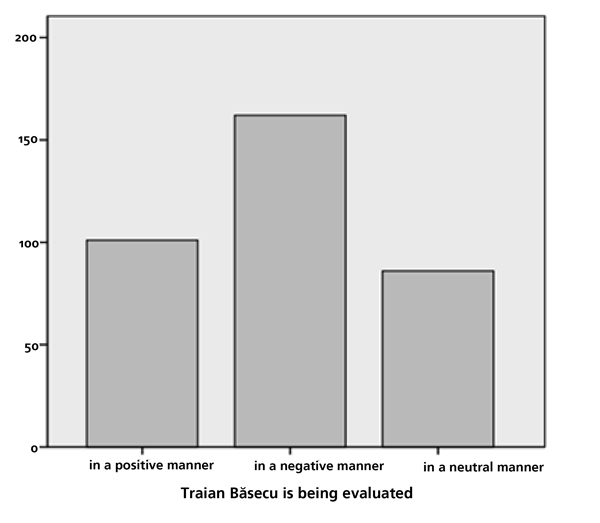
Fig. 9. Overall distribution of
positive, negative and neutral references of Băsescu
Another measure of personalization that we introduced into our analysis
concerned the presence of this candidate’s pictures in most of the articles. As
figure 8 illustrates, no such tendency was observed in all of the three tabloids
(x2(2, N = 394) = 49.491, p < .05).
Apropo included in 43.6 % of its articles pictures illustrating Traian Băsescu
(N=39; SD=0.5), followed by Libertatea, 32.3% (N=282; SD=0.46) and Cancan, 5.5%
(N=73, SD= 0.22). Hence, since none of the tabloids seemed to have dedicated to
pictures an essential part of their coverage, we considered that the
personalization hypothesis was not confirmed in this regard either.
Still, our analysis did not consider the size of the pictures compared to that
of texts, an element often associated with tabloidization (Franklin, 1997;
2008). Nonetheless, under the terms of this research, the personalization
hypothesis does not stand; but would still require an evolutionary approach to
see whether in the past Romanian tabloids have included fewer pictures in their
articles.
5.3. Negativism (negative coverage)
The third main hypothesis of our empirical demarche concerned the presence of
negativism in Traian Băsescu’s coverage. It was assessed by means of the overall
evaluations provided by the three tabloids and specifically considering: him as
a candidate (candidacy and campaign events; in the televised debates); as the
person potentially hitting the child; his family; his image as the current
president (deficits of current government).
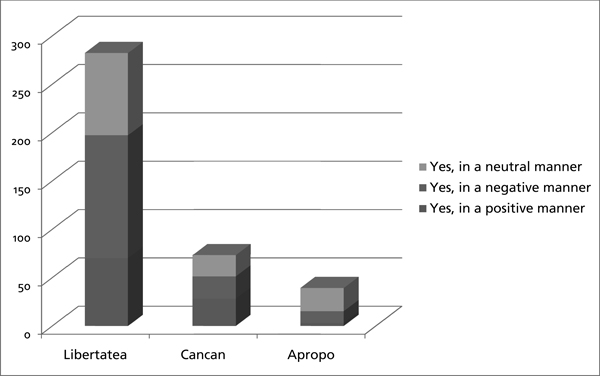
Fig.10. Distribution of positive,
negative and neutral references of Băsescu in each of the tabloids
Our analysis will outline first how the three tabloids presented him overall,
and then will proceed at illustrating how they evaluated him in association with
each of the abovementioned themes.
As figure 9 shows, throughout our period of analysis, it would seem that
Băsescu was overall evaluated in a negative manner (50,6%), and to a lesser
extent in a positive (19,3%) or neutral way (30,1%) (N=394). However, if we were
to divide these categories into negative and non-negative (positive and neutral)
references, our perspective over his evaluation would probably be different.
Thus, we cannot claim that, overall, the assessments of this candidate have been
clearly negative, unless we also explore in what period they occurred and which
of the tabloids might have influenced this overall trend.
The main tabloids who have had negative references concerning this candidate
are Libertatea (36,9%) and Apropo (18,5%) (x2 (6, N = 394) = 69.192, p
< .05). As figure 10 shows, Libertatea was also the sheet that provided most of
the positive and neutral evaluations of Traian Băsescu, due to its high number
of articles compared to the other online tabloids.
Before the official beginning of the electoral campaign, the candidate was
referred at mostly in a negative fashion (37.7%), and to a lesser extent in a
positive (24.7 %) or neutral manner (20.1%) (N=154; SD=0.99). In this interval,
from the sub-themes of what we called „deficits of the current government”, he
mostly received negative references in relation to the theme of strikes, wage
reduction or the economic crisis (13.6%); and to a lower degree with political
conflicts (5.8%) and the idea of corruption (5.2%) (x2 (12, N = 154) = 75.043,
p < .05) Thus, the candidate was framed as the president responsible for
the economic crisis, which is probably why the references concerning his family
were so scarce (5,23%; N=154; SD=0.51).
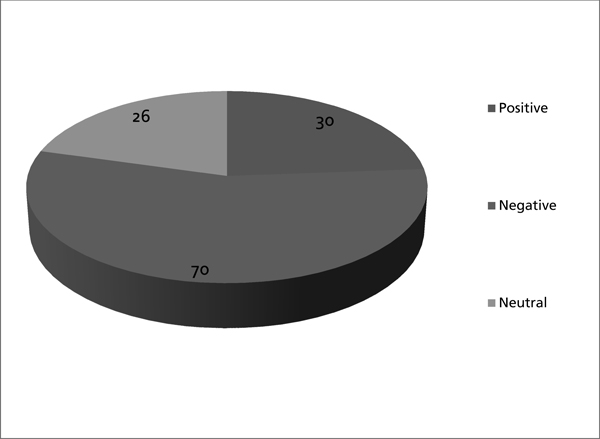
Fig. 11. Overall evaluation in
connection with campaign events
Furthermore, in this time range, the candidate’s negative evaluations related
to his family represented only 0,29% of all mentions, whilst the positive ones
comprised 1%. We attributed this to the fact that the tabloid with the highest
number of articles, Libertatea, emphasized on the illness of Băsescu’s mother in
a compassionate manner.
In the electoral campaign period, the overall trend of presenting Băsescu was
maintained, mostly negative (43.3%) and to a lesser extent positive (26.3%) or
neutral (22,9%) (N=240; SD=0.87). From the category entitled „deficits of the
current government”, the main topics he was associated negatively with during
this time consist of corruption (6.3%) and strikes, wage reduction or the
economic crisis (5.4%) (x2 (12, N = 240) = 28.932, p < .05) . We also
found that there is a correlation between how Băsescu is evaluated and his
association with the deficits of the current government (ρ=.255; ρ>0,01; N=394).
Thus, the more a tabloid mentions this topic, the more this candidate receives
negative references.
As for the way in which the current president was presented in connection with
his family, no negative evaluations exist in the electoral campaign period.
However, this tendency changes when it comes with how the candidate is
illustrated in relation to his campaign events. As figure 11 shows, the negative
references outnumber the positive and neutral ones (N=126). Also, we found that
there is a significant, yet weak correlation between the way in which he is
generally evaluated and his assessments, not only in the campaign period
(ρ=.183; ρ>0,01; N=394).
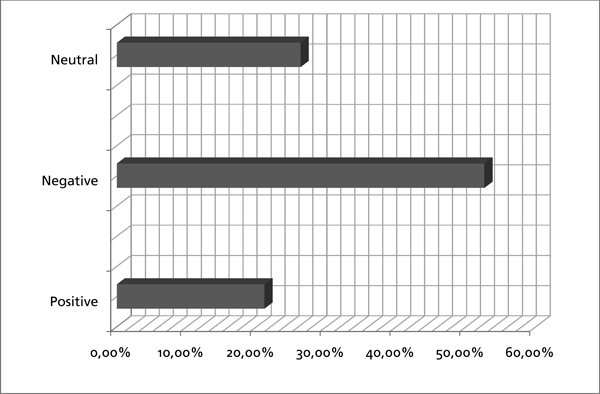
Fig. 12. Types of references to
the candidate in connection with the televised debates
When designing the categories of our analysis, we considered the televised
debates a distinct moment of illustrating the candidates, which is why we did
not include them in the category of the campaigning events. Within the articles
dedicated to this subject, Băsescu received 52.6% negative evaluations, 26.3%
neutral assessments and 21.1% positive references, as illustrated below (x2(6, N
= 19) = 27.932, p < .05). From this perspective, his portrayal would
not seem to have been marked by negativism. Still, we have to consider that if
these negative references were added to those included in the campaign events
category, the resulting image would differ. In this regard, a higher number of
positive evaluations in connection to the televised debates would have provided
for an overall balanced image of Băsescu as a candidate.
As for how the tabloids presented this candidate in relation to the issue of
the alleged child agression, we found that, overall, Băsescu received mostly
positive references (81,81%, N=22). They were found mostly in Libertatea’s
coverage of the event (68,42%), followed by Cancan (26,31%) and Apropo (5,27%)
(x2(9, N = 19) = 35.429, p < .05).
Hence, the hypothesis of negativism is only partially confirmed. While overall,
Traian Băsescu was evaluated in a negative manner, this assessment varies within
each of the subcategories we subjected to this analysis and, for some topics, in
certain periods and tabloids. Thus, the tabloid with the highest number of
negative references concerning this candidate was Libertatea, followed by Apropo
and Cancan. Libertatea was also the sheet providing most of the mentions about
Băsescu
Before the electoral campaign, Băsescu, as the current president, was referred
at mostly in a negative manner, in relation to the government’ deficits and
specifically the theme of strikes, wage reduction (or the economic crisis).
Within this time range, the negative references associated to his family were
outnumbered by the positive ones.
In the electoral campaign period, the overall trend of presenting Băsescu was
preserved. Thus, he has been portrayed in a negative fashion, in connection to
the subject of the economic crisis. This tendency was also maintained in what
concerns his evaluation as a candidate: the references concerning his campaign
events are mostly negative and those relating to the televised debates are
equally negative and neutral. Although we might understand the latter as a sign
of a balanced assessment, if we were to add the mentions from this category with
those included in the campaign events category, we would obtain a rather
negative image of this candidate.
As for the way in which the current president was presented in relation to his
family, no negative evaluations exist in this period.
In connection to the issue of the alleged child aggression, we found that
Băsescu received mostly positive references. They were found mostly in
Libertatea’s coverage of the event, followed by Cancan and Apropo.
Thus, despite the fact that this candidate was mostly evaluated in a
negative fashion, due to his association with the deficits of the current
government and the negative assessments he received during the electoral
campaign, our hypothesis does not fully stand. In relation to
Băsescu’s family and his alleged aggression of a child, the tabloids have
illustrated a positive outlook over the candidate.
While it is true that our research drew the gloomiest picture of what one might
call „negativism”, it did so not only to prove the lack of consistency in some
academic accounts of tabloidization, but also to highlight the specificity of
Romanian tabloids. In the terms of our research hypothesis, it is safe to claim
that tabloids’ coverage of the last presidential campaign was somewhat marked by
negativism.
However, the reasons that lay behind this negative coverage might exceed the
boundaries of its commercial rationale. Particularly in the case of the 2009
campaign, when the Romanian society was starting to manifest its deepest
concerns about its social and political being in the context of the economic
crisis, the tendency of evaluating the current president in negative terms
is, to a certain extent, understandable. Furthermore, considering that
Băsescu‘s appraisal throughout the electoral campaign was somewhat influenced by
the different breaches of civility in the campaign itself (clashes between party
members, inter-party verbal attacks, populist campaigning strategies); its
negative tone is justifiable, to a certain extent.
6. Conclusions of the empirical analysis. Discussion
The first hypothesis of our investigation of the tabloidization
phenomenon was that if the references concerning Băsescu’s allegedly aggression
of a child outnumber those concerning his campaign events, candidature or
presidential position (deficits of the government); than the tabloids are a
subject of a high degree of sensationalism.
Because in the period when this topic appeared on the sheets’ agenda, its
proportion was lower than all of the abovementioned categories, we considered
that this hypothesis was not confirmed. Most of their
references approached Traian Băsescu’s campaign events, and not his alleged act
of violence. This trend was also confirmed in the case of each tabloid. Although
the references concerning this potential aggression outnumbered those
illustrating various deficits of the government (the economic crisis, the
cut-backs in public functionaries’ wages, union strikes, political conflicts,
accusations of corruption); we considered it a result of the long period in
which these political and social events had been highly broadcasted. Thus, since
their frequency had already diminished by the time this new controversial issue
appeared, we did not consider this finding relevant to our analysis.
Still, our empirical undertaking did not explore deeper into how the campaign
events themselves might have represented a source of sensationalism. Since they
also included references concerning different political initiatives for the
future, we considered that this category is not one to illustrate such a trait.
Further research will need to outline if what we have denominated as „campaign
events” (events happening in the course of the campaign that also include
parties’ promoting actions) is a category increasingly influenced by different
sensationalist facts.
The second assumption of our empirical research was that if the
frequency of references concerning the candidate’s family is higher than that of
the mentions regarding his image as a candidate (campaign events) or as the
president (issues of the government); then one can speak of a high degree of
personalization in the tabloid press. By exploring the candidate’s associations
with the categories specified in the methodological section of this paper, we
found that overall, this hypothesis does not confirm. The references
about Băsescu’s family amounted less than those illustrating campaign events or
deficits of the government. Thus, the tabloids have emphasized on Băsescu’s
campaign events and associations with the current government’s deficits.
Another measure of personalization that we introduced into our
analysis concerned the presence of this candidate’s pictures in most of the
articles. Since none of the tabloids seemed to have dedicated to pictures
an important part in their coverage, we considered that the personalization
hypothesis was not confirmed in this regard either. Yet, fully
validating such a hypothesis in the Romanian media landscape would require an
evolutionary approach to see whether in the past Romanian tabloids have included
fewer pictures in their articles.
Although under the terms of our framework, the hypothesis of personalization
was infirmed, this evaluation can be considered somewhat questionable from a
particular angle. If we consider the higher number of references dedicated to
Traian Băsescu’s family than that of his participation and performance in the
televised debates, then this may represent itself a sign of personalization.
Still, considering the low percentages of both of these themes and the reduced
number of articles provided by Cancan and Apropo, by comparison with Libertatea,
reaching such a conclusion would need wider samples and further investigation.
In what regards the hypothesis of negativism, this was only
partially confirmed. Despite the fact that this candidate was mostly
evaluated in a negative fashion, due to his association with the current
government’ deficits, specifically, the economic crisis, and the negative
assessments he received during the electoral campaign, our hypothesis does not
fully stand. In relation to Băsescu’s family and his alleged aggression of a
child, the tabloids have illustrated a positive outlook over the candidate. For
the time being, it is safe to claim that the tabloids’ coverage of the last
presidential campaign was somewhat marked by negativism.
While it is true that our research drew an extreme picture of the negativism
hypothesis, it did so not only to prove the lack of consistency in some academic
accounts of tabloidization, but also to highlight the specificity of Romanian
tabloids.
The reasons that lay behind this negative coverage might exceed the
boundaries of its commercial rationale. Particularly in the case of the
2009 campaign, when the Romanian society was starting to manifest its deepest
concerns about its social and political being in the context of the economic
crisis, the tendency of evaluating the current president in negative terms
is understandable. Furthermore, considering that Băsescu‘s appraisal
throughout the electoral campaign was somewhat influenced by the different
breaches of civility in the campaign itself (clashes between party members,
inter-party verbal attacks, populist campaigning strategies); its negative tone
is consistent, to a certain extent.
Hence, in the framework of our research design, we can say that the only mark
of tabloidization in the Romanian tabloid media is that of negativism. Still, as
we have shown, this trait may be considered somewhat justified by the contextual
variables that defined the 2009 presidential campaign.
Perhaps a qualitative approach of the language and style used in the Romanian
tabloids would make for a better instrument for assessing their degree of
tabloidization. While coding the data, we noticed that some of the headlines
have made use of various humorous forms (“They had some laughs in the
[televised] confrontation!”83;
„The partnership for Timişoara was signed, but the people from Timişoara have
not resigned [to it]84”).
Thus, they might represent a sign of what Fiske called „ideological resistance”85.
Nonetheless, future research in the Romanian tabloid media should explore this
assumption.
The findings of our research seem to point that there is a certain degree of
similarity between the Romanian and the Bulgarian tabloids, as illustrated in
the Media Sustainability Index86.
As shown in the course of our analyses, the three sheets have dedicated an
important place to the issues of the current government and have also mentioned
the parties’ plans for the future mandate. Thus, in the analysis of
transformations in political communication, it would be interesting to see
whether there is a specific, Eastern European type of tabloidization; that
implies an inverse polarization between what is commonly understood as the style
of tabloids and that of the so-called „quality press”.
So what are the implications of this research for the Romanian public sphere?
As we have seen, in the terms proposed by our framework, the three tabloids have
neither been affected by sensationalism or personalization. Their negative
coverage on some issues can be understood as a healthy democratic attitude
toward the troubles of the Romanian society and how they are dealt with by the
national authorities. Because usually internal issues are attributed to the
president, although his prerogatives are reduced, we considered the tabloids’
tendency to ascribe them to Băsescu as natural. Furthermore, this might also be
the result of his previous campaigning actions, which have conveyed the idea of
the omnipotent president.
For the time being, it is difficult to say whether these tabloids might have
coagulated in an alternative public sphere. An investigation of the mainstream
„quality” press would be needed in this regard and so would a further exploring
into the language and style of the tabloids.
The similarities observed between Romania and Bulgaria in what concerns the
approach of political issues in tabloids raise a number of questions: Are there
other common patterns in the East European mediated public spheres? Or is there
an Eastern European public sphere? If so, what are issues it is confronted with?
Bibliography
Adorno, Theodor, Horkheimer Max, „The Culture Industry: Enlightenment as
Mass Deception”, in Simon During (editor), The Cultural Studies Reader
, London, Routledge, 1993.
Asp, Kent, Esaiasson, Peter, „The Modernization of Swedish Campaigns:
Individualization, Professionalization, and Medialization”, in David L. Swanson,
Paolo Mancini (editors) Politics, Media, and Modern Democracy. An
International Study of Innovations in Electoral Campaigning and Their
Consequences , Westport, Connecticut, Praeger, 1996.
Aszalos, Cristian, Crampoanele României şchioape. Tabloidizarea presei
sportive româneşti (The crampons of limping Romania. The tabloidization
of the Romanian sport press) ,Cluj-Napoca, Eikon, 2011.
Barnett, Steven, „Dumbing Down or Reaching Out : Is it Tabloidisation wot done
it ?”, The Political Quarterly 69(1998).
Baum, Matthew A., „Sex, lies, and war: How soft news brings foreign policy to
the inattentive public”, American Political Science Review, 96/
1(2002).
Beciu, Camelia, Comunicare şi discurs mediatic. O lectură sociologică
(Communication and media discourse. A sociological reading) ,
Bucharest, Comunicare.ro, 2009.
Beciu, Camelia, Sociologia comunicării şi a spaţiului public (The
sociology of communication and of the public space) , Iaşi, Polirom, 2011.
Bird, S. Elizabeth, „News We Can Use : An Audience Perspective On The
Tabloidisation of News in the United States”, The Public 5/3 (1998).
Blumler, Jay, Gurevitch, Michael, The Crisis of Public Communication,
London, Routledge, 1995).
Blumler, Jay, Kavanaugh, Dennis, „The Third Age of Political Communication:
Influences and Features”, Political Communication 16 (1999).
Bourdieu, Pierre, On television, translated by Priscilla Parkhurst
Ferguson, New York, The New Press, 1996.
Brants, Kees,“Who’s Afraid of Infotainment?” European Journal of
Communication 13/ 3(1998).
Burnes, Susan, „Metaphors in press reports of elections: Obama walked on water,
but Musharraf was beaten by a knockout” , Journal of Pragmatics 43/8
(2011).
Cappella, Joseph N., Jamieson, Kathleen Hall, Spiral of Cynicism: The Press
and the Public Good , New York, Oxford University Press, 1997.
Caspi, Dan, „American-Style Electioneering in Israel: Americanization versus
Modernization”, in David L. Swanson, Paolo Mancini (editors) Politics,
Media, and Modern Democracy. An International Study of Innovations in Electoral
Campaigning and Their Consequences (Westport, Connecticut: Praeger,
Dahlgren, Peter, Television and the Public Sphere. Citizenship, Democracy
and the Media (London: Sage Publications, 1995).
De Beus, Jos, „Audience Democracy: An Emerging Pattern in Postmodern Political
Communication”, in Kees Brants, Katrin Voltmer (editors) Political
Communication in Postmodern Democracy. Challenging the Primacy of Politics
(New York: Palgrave Macmillan, 2011).
Delli Carpini, Michael X.; Williams, Bruce A.,“Let us infotain you: Politics in
the new media environment”, in W. Lance Bennett, Robert M. Entman (editors),
Mediated Politics. Communication in the future of democracy (New York:
Cambridge University Press, 2001).
Eisenlohr, Patrick, „Religious Media, Devotional Islam, and the Morality of
Ethnic Pluralism in Mauritius“, World Development 39/2 (2010).
Esser, Frank, „Tabloidization’ of News : A Comparative Analysis of
Anglo-American and German Press Journalism”, European Journal of
Communication 14/ 3 (1999).
Ferré-Pavia, Carme, Gayà-Morlà, Catalina, „Infotainment and citizens ’
political perception : Who’ s afraid of «Polònia»”? Catalan Journal of
Communication & Cultural Studies, 3/1(2011).
Fiske, John, Television Culture (London and New York: Routledge,
1987).
Fiske, John,“Popularity and the Politics of Information”, in Peter Dahlgren,
Collin Sparks (editors) Journalism and Popular Culture (Newbury Park:
Sage, 1992).
Franklin, Bob, „Newszak: entertainment versus news and information”, in Anita
Biressi & Heather Nunn (editors) The Tabloid Culture Reader (New York:
McGraw Hill Open University Press, 2008).
Franklin, Bob, Newszak and Newsmedia. (London: Arnold, 1997).
Gitlin, Todd,“Bites and blips : chunk news , savvy talk and the bifurcation of
American politics”, in Peter Dahlgren, Collin Sparks (editors),
Communication and Citizenship: Journalism and the Public Sphere in the New Media
Age , London, Routledge, 1991.
Głowacki, Michał, Dobek-Ostrowska, Bogusława, Comparing Media Systems in
Central Europe (Wrocław: Wydawnictwo Uniwersytetu
Wrocławskiego, 2008).
Glynn, Kevin, „Tabloid Television’s Transgressive Aesthetic: A Current Affair
and the «Shows that Taste Forgot»”, Wide Angle 12/2 (1990).
Habermas, Jürgen, The structural transformation of the public sphere. An
inquiry into a Category of Bourgeois Society , translated by Thomas Burger
in collaboration with Frederick Lawrence (Cambridge: MIT Press, 1962/ 1989), 27.
Hallin, Daniel C., „Sound bite news: Television coverage of elections,
1968–1988”, Journal of Communication, 42/ 2 (1992).
Hart, Roderick P., Seducing America: How Television Charms the Modern Voter,
New York, Oxford University Press, 1994.
Hartley, John, Green, Joshua, „The public sphere on the beach”, European
Journal of Cultural Studies, 9/3 (2006).
Himmelstrand, Ulf, „A Theoretical and Empirical Approach to Depoliticization
and Political Involvement”, Acta Sociologica. Approaches to the Study of
Political Participation, 6(1962).
Holly, Werner, „Tabloidisation of political communication in the public
sphere”, in Ruth Wodak,Veronika Koller, (editors) Handbook of Communication
in the Public Sphere (Berlin: Mouton de Gruyter, 2008).
Holtz-Bacha, Christina, „Professionalization of Political Communication”,
Journal of Political Marketing 1/4 (2002).
Jakubowicz, Karol, „Television and Elections in Post-1989 Poland: How Powerful
Is the Medium?”, in David L. Swanson, Paolo Mancini (editors) Politics,
Media, and Modern Democracy. An International Study of Innovations in Electoral
Campaigning and Their Consequences (Westport, Connecticut: Praeger,
Jamieson, Kathleen Hall, Birdsell, David S., Presidential debates. The
challenge of creating an informed electorate , New York, Oxford University
Press, 1988.
Johansson, Sofia, „«They Just Make Sense»: Tabloid Newspapers as an Alternative
Public Sphere”, in Richard Butsch, (editor) Media and Public Spheres,
New York, Palgrave Macmillan, 2007.
Jones, Jeffrey P., Entertaining politics: new political television and
popular culture, Maryland , Rowman and Littlefield Publishers, 2005).
Klein, Ulrike,“Tablodised political coverage in Bild-Zeitung”, The Public
5/3 (1998).
Langer, John, Tabloid television: popular journalism and the ‘other news’
, London & New York, Routledge, 1998.
Lee, Chin-Chuan, Chinese Media,Global Contexts , London, Routledge,
2003.
Livingstone, Sonia, Lunt, Peter, Talk on television. Audience Participation
and Public Debate ,New York, Routledge, 1994/2001.
Lunt, Peter, Pantti, Mervi, „Popular Culture and the Public Sphere: Currents of
Feeling and Social Control in Talk Shows and Reality TV”, in Richard Butsch
(editor) Media and Public Spheres New York, Palgrave Macmillan, 2005.
Manning, Paul, News and News Sources: A Critical Introduction, London,
Sage, 2001.
Mazzoleni, Gianpietro, Schulz, Winfried, „«Mediatization» of Politics: A
Challenge for Democracy”? Political Communication 16/ 3 (1999).
McGuigan, Jim, „The Cultural Public Sphere”, European Journal of Cultural
Studies 8/4 (2005).
McKee, Allan, The Public Sphere: An Introduction (New York: Cambridge
University Press, 2005)
McNair, Brian, Journalism and Democracy: An Evaluation of the Political
Public Sphere , London, Routledge, 2000.
Mehl, Dominique, „The television of intimacy. Meeting a social need”,
Réseaux. The French journal of communication 4/ 1(1996).
Negrine, Ralph, Papathanassopoulos, Stylianos, „The «Americanization» of
Political Communication: A Critique”, The International Journal of Press/
Politics, 1/2 (1996).
Nörnebring, Henrik, Jönsson, Anna Maria, „Tabloid Journalism and the Public
Sphere: a historical perspective on tabloid journalism”, Journalism Studies
5/3 (2004).
Postman, Neil, Amusing Ourselves to Death: Public Discourse in the Age of
Showbusiness , New York, Penguin, 1986.
Putnam, Robert, Bowling Alone: The Collapse and Revival of American
Community , New York, Simon & Schuster, 1995.
Roberts, John Michael, „Introducing Competence and the Public Sphere”, in
The Competent Public Sphere , New York, Palgrave Macmillan, 2009.
Robinson, Michael J.,“Public affairs television and the growth of political
malaise: The case of «The selling of the pentagon»”, The American Political
Science Review, 70/2 (1976).
Rooney, Dick, „Dynamics of the British tabloid press”, The Public 5/3
(1998).
Scammel, Margaret,“The wisdom of the war room: US campaigning and
Americanization”, Media, Culture and Society, 20 (1998).
Schiff, Frederick, „The Dominant Ideology and Brazilian Tabloids: News Content
in Class-Targeted Newspapers”, Sociological Perspectives 39/1 (1996).
Sparks, Collin, „Popular Journalism: Theories and Practice”, in Peter Dahlgren,
Collin Sparks (editors) Journalism and Popular Culture, London, Sage,
1992.
Sparks, Collin, Tulloch, John, Tabloid tales: Global debates over media
standards, Lanham, MD: Rowman and Littlefield, 2000.
Stamper, Judith, Brants, Kees, „A Changing Culture of Political Television
Journalism”, in Kees Brants, Katrin Voltmer (editors) Political
Communication in Postmodern Democracy. Challenging the Primacy of Politics
, New York, Palgrave Macmillan, 2011.
Street, John, „The Transformation of Political Modernity?”, in Barrie Axford,
Richard Huggins (editors) New Media and Politics , London, Sage
Publications, 2001.
Street, John, „«Prime time politics»: Popular culture and politicians in the
UK”, The Public 7/2 (2000).
Street, John, Inthorn, Sanna, Scott, Martin, „Playing at Politics? Popular
Culture as Political Engagement”, Parliamentary Affairs 65 (2012).
Strömbäck, Jesper, „Four Phases of Mediatization: An Analysis of the
Mediatization of Politics”, International Journal of Press/Politics
13/3 (2008).
Swanson, David L., Mancini, Paolo (editors) Politics, Media, and Modern
Democracy. An International Study of Innovations in Electoral Campaigning and
Their Consequences, Westport, Connecticut, Praeger, 1996.
Temple, Mick,“Dumbing Down is Good for You”, British Politics 1(2006)
NOTE
1
Beneficiary of the „Doctoral Scholarships for a Sustainable
Society” project, co-financed by the European Union through the European
Social Fund, Sectoral Operational Programme Human Resources and
Development, 2007-2013.
2 Jürgen Habermas, The structural
transformation of the public sphere. An inquiry into a Category of
Bourgeois Society , translated by Thomas Burger in collaboration with
Frederick Lawrence (Cambridge: MIT Press, 1962/ 1989), 27.
3 A specific line of theorization in the
established literature has analyzed how the initial Habermasian definition
can generate new paradigms of the public sphere. We consider the following
works as being illustrative for this type of theoretical research: Patrick
Eisenlohr, „Religious Media, Devotional Islam, and the Morality of Ethnic
Pluralism in Mauritius“, World Development 39/2 (2010); Jim
McGuigan, „The Cultural Public Sphere”, European Journal of Cultural
Studies 8/4 (2005); Allan McKee, The Public Sphere: An
Introduction (New York: Cambridge University Press, 2005); John
Michael Roberts, „Introducing Competence and the Public Sphere”, in The
Competent Public Sphere (New York: Palgrave Macmillan, 2009).
4 For instance the stand promoted by:
Roderick P. Hart, Seducing America: How Television Charms the Modern
Voter (New York: Oxford University Press, 1994); Kathleen Hall
Jamieson, David S. Birdsell, Presidential debates. The challenge of
creating an informed electorate (New York: Oxford University Press,
1988).
5 Ralph Negrine, Stylianos
Papathanassopoulos, „The «Americanization» of Political Communication: A
Critique”, The International Journal of Press/Politics, 1/2
(1996); Margaret Scammel, „The wisdom of the war room: US campaigning and
Americanization”, Media, Culture and Society, 20 (1998).
6 Jos De Beus, „Audience Democracy: An
Emerging Pattern in Postmodern Political Communication”, in Kees Brants,
Katrin Voltmer (editors) Political Communication in Postmodern
Democracy. Challenging the Primacy of Politics (New York: Palgrave
Macmillan, 2011).
7 The alleged tabloidization of
political communication has been both postulated and explored in studies
such as: S. Elizabeth Bird, „News We Can Use : An Audience Perspective On
The Tabloidisation of News in the United States”, The Public 5/3
(1998); Frank Esser, „Tabloidization’ of News : A Comparative Analysis of
Anglo-American and German Press Journalism”, European Journal of
Communication 14/ 3 (1999); Bob Franklin, Newszak and Newsmedia.
(London: Arnold, 1997); Bob Franklin, „Newszak: entertainment versus news
and information”, in Anita Biressi & Heather Nunn (editors) The Tabloid
Culture Reader (New York: McGraw Hill Open University Press, 2008);
Ulrike Klein, „Tablodised political coverage in Bild-Zeitung”, The
Public 5/3 (1998); Dick Rooney, „Dynamics of the British tabloid
press”, The Public 5/3 (1998); Raymond Williams,
Communications (Harmondsworth, UK: Penguin, 1962).
8 Franklin, Newszak, 1997;
Joseph N.Cappella, Kathleen Hall Jamieson, Spiral of Cynicism: The
Press and the Public Good (New York: Oxford University Press, 1997).
9 Franklin, Newszak, 1997; Paul
Manning, News and News Sources: A Critical Introduction (London:
Sage, 2001); Brian McNair, Journalism and Democracy: An Evaluation of
the Political Public Sphere (London: Routledge, 2003); Mick Temple,
„Dumbing Down is Good for You”. British Politics 1(2006)
10 In this regard Rooney, „Dynamics”,
1998 represents an illustrative example of such a positioning.
11 Bird, „News”, 1998.; Pierre
Bourdieu, On television, translated by Priscilla Parkhurst
Ferguson (New York: The New Press, 1996); Franklin, Newszak,
1997; John Langer, Tabloid television: popular journalism and the
‘other news’ (London & New York: Routledge, 1998); Rooney, „Dynamics”,
1998.
12 Habermas, „Structural”, 1962/ 1989.
13 Habermas, „Structural”, 1962/ 1989.
14 Jay G. Blumler, Dennis Kavanaugh,
„The Third Age of Political Communication: Influences and Features”,
Political Communication 16 (1999); Jesper Strömbäck, „Four Phases
of Mediatization: An Analysis of the Mediatization of Politics”,
International Journal of Press/Politics 13/3 (2008); Judith Stamper,
Kees Brants, „A Changing Culture of Political Television Journalism”, in
Kees Brants, Katrin Voltmer (editors) Political Communication in
Postmodern Democracy. Challenging the Primacy of Politics (New York:
Palgrave Macmillan, 2011).
15 Gianpietro Mazzoleni, Winfried
Schulz, „«Mediatization» of Politics: A Challenge for Democracy”?
Political Communication 16/ 3 (1999).
16 Peter Dahlgren, Television and
the Public Sphere. Citizenship, Democracy and the Media (London: Sage
Publications, 1995).
17 Theodor Adorno, Max Horkheimer,
„The Culture Industry: Enlightenment as Mass Deception”, in Simon During
(editor), The Cultural Studies Reader (London: Routledge, 1993);
Jay Blumler, Michael Gurevitch, The Crisis of Public Communication
(London: Routledge, 1995); Todd Gitlin, „Bites and blips : chunk news ,
savvy talk and the bifurcation of American politics”, in Peter Dahlgren,
Collin Sparks (editors), Communication and Citizenship: Journalism and
the Public Sphere in the New Media Age (London: Routledge, 1991);
Hart, Seducing, 1994; Jamieson, Birdsell, Presidential
debates, 1988; Dominique Mehl, „The television of intimacy. Meeting a
social need”, Réseaux. The French journal of communication 4/
1(1996); Neil Postman, Amusing Ourselves to Death: Public Discourse in
the Age of Showbusiness (New York: Penguin, 1986).
18 Robert Putnam, Bowling Alone:
The Collapse and Revival of American Community (New York: Simon &
Schuster, 1995).
19 Bourdieu, On television,
1996 ; Capella, Jamieson, Spiral, 1997.
20 Franklin, Newszak, 1997;
Franklin , „Newszak”, 2008.
21 Adorno, Horkheimer, „The Culture”,
1993.
22 Mehl, „The television”, 1996.
23 Michael X. Delli Carpini, Bruce
A.Williams, „Let us infotain you: Politics in the new media environment”,
in W. Lance Bennett, Robert M. Entman (editors), Mediated Politics.
Communication in the future of democracy (New York: Cambridge
University Press, 2001).
24 Rosa Van Santen, Popularization
& Personalization. A Historical and Cultural Analysis of 50 Years of Dutch
Political Television Journalism (Amsterdam, the Netherlands:
Almanakker, Oosterhout, 2012).
25 Kees Brants, „Who’s Afraid of
Infotainment?” European Journal of Communication 13/ 3(1998); John
Street, „«Prime time politics»: Popular culture and politicians in the UK”,
The Public 7/2 (2000).
26 Camelia Beciu, Comunicare şi
discurs mediatic. O lectură sociologică ( Communication and media
discourse. A sociological reading) (Bucharest: Comunicare.ro, 2009);
Camelia Beciu, Sociologia comunicării şi a spaţiului public ( The
sociology of communication and of the public space) (Iaşi: Polirom,
2011); Blumler, Kavanaugh, „The Third”, 1999.; Ulf Himmelstrand, „A
Theoretical and Empirical Approach to Depoliticization and Political
Involvement”, Acta Sociologica. Approaches to the Study of Political
Participation, 6(1962); Christina Holtz-Bacha, „Professionalization of
Political Communication”, Journal of Political Marketing 1/4
(2002); David L. Swanson, Paolo Mancini (editors) Politics, Media, and
Modern Democracy. An International Study of Innovations in Electoral
Campaigning and Their Consequences (Westport, Connecticut: Praeger,
1996).
27 McNair, Journalism,2000;
Postman, Amusing, 1986; Temple, „Dumbing”, 2006.
28 Gitlin, „Bites”, 1991; Daniel C.
Hallin, „Sound bite news: Television coverage of elections, 1968–1988”,
Journal of Communication, 42/ 2 (1992); Hart, Seducing, 1994;
Michael J. Robinson, „Public affairs television and the growth of political
malaise: The case of «The selling of the pentagon»”, The American
Political Science Review, 70/2 (1976).
29 Gitlin, „Bites”, 1991.
30 Blumler & Kavanaugh, 1999;
Himmelstrand, „A Theoretical,” 1962; Holtz-Bacha, „Professionalization”,
2002; Swanson, Mancini, Politics, 1996; Van Santen,
Popularization, 2012.
31 Beciu, Comunicare, 2009;
Beciu, Sociologia, 2011; Blumler, Kavanaugh, „The Third”, 1999;
Holtz-Bacha, „Professionalization”, 2002; Swanson, Mancini, Politics,
1996.
32 De Beus, „Audience” : 19.
33 Capella, Jamieson, Spiral,
1997.
35 Brants, „Who’s Afraid”, 1998;
Dahlgren, Television,1995; Jeffrey P. Jones, Entertaining
politics: new political television and popular culture (Maryland:
Rowman and Littlefield Publishers, 2005).
36 Brants, „Who’s Afraid”, 1998.
36 e.g. Dan Caspi, „American-Style
Electioneering in Israel: Americanization versus Modernization”, in David
L. Swanson, Paolo Mancini (editors) Politics, Media, and Modern
Democracy. An International Study of Innovations in Electoral Campaigning
and Their Consequences (Westport, Connecticut: Praeger, 1996); Kent
Asp, Peter Esaiasson, „The Modernization of Swedish Campaigns:
Individualization, Professionalization, and Medialization”, in David L.
Swanson, Paolo Mancini (editors) Politics, Media, and Modern Democracy.
An International Study of Innovations in Electoral Campaigning and Their
Consequences (Westport, Connecticut: Praeger, 1996).
37 Delli Carpini,Williams, „Let us
infotain”, 2001; Jones, Entertaining, 2005; Sonia Livingstone,
Peter Lunt, Talk on television. Audience Participation and Public
Debate (New York: Routledge, 1994/2001); McNair, Journalism,2003;
Street, „«Prime time politics»”, 2000; John Street, „The Transformation of
Political Modernity?”, in Barrie Axford, Richard Huggins (editors) New
Media and Politics (London: Sage Publications, 2001); Temple,
„Dumbing”, 2006; Liesbet Van Zoonen, Stephen Coleman, Anke Kuik, „The
Elephant Trap: Politicians Performing in Television Comedy”, in Kees
Brants, Katrin Voltmer (editors) Political Communication in Postmodern
Democracy. Challenging the Primacy of Politics (New York: Palgrave
Macmillan, 2011).
38 Matthew A. Baum, „Sex, lies, and
war: How soft news brings foreign policy to the inattentive public”,
American Political Science Review, 96/ 1(2002); Van Zoonen, Coleman,
Kuik, „The Elephant”, 2011; Temple, „Dumbing”, 2006.
39 Carme Ferré-Pavia, Catalina
Gayà-Morlà, „Infotainment and citizens ’ political perception : Who’ s
afraid of «Polònia»”? Catalan Journal of Communication & Cultural
Studies, 3/1(2011).
40 Jones, Entertaining, 2005;
Livingstone, Lunt, Talk, 1994/2001.
41 John Street, Sanna Inthorn, Martin
Scott, „Playing at Politics? Popular Culture as Political Engagement”,
Parliamentary Affairs 65(2012); Liesbet Van Zoonen, Entertaining
the citizen: When politics and popular culture converge (Oxford, UK:
Rowman & Littlefield, 2005).
42 Ferré-Pavia, Gayà-Morlà,
„Infotainment”, 2011.
43 Peter Lunt, Mervi Pantti, „Popular
Culture and the Public Sphere: Currents of Feeling and Social Control in
Talk Shows and Reality TV”, in Richard Butsch (editor) Media and Public
Spheres (New York: Palgrave Macmillan, 2005); David Nolan,
„Tabloidisation Revisited” (1998),
http://search.informit.com.au/documentSummary;dn=427191853059782;res=IELHSS
1998, retrieved 03.08. 2012.
44 John Fiske, Television Culture
(London and New York: Routledge,1987).
45 John Hartley, Joshua Green, „The
public sphere on the beach”, European Journal of Cultural Studies
9/3 (2006); McKee, The Public Sphere, 2005.
46 McGuigan, „The Cultural”, 2005,
435.
47 Van Zoonen, Coleman, Kuik, „The
Elephant”, 2011.
48 Collin Sparks, „Popular Journalism:
Theories and Practice”, in Peter Dahlgren, Collin Sparks (editors)
Journalism and Popular Culture (London: Sage, 1992).
49 Blumler, Kavanaugh, „The Third”,
1999; Gitlin, „Bites”, 1991; Henrik örnebring, Anna Maria Jönsson, „Tabloid
Journalism and the Public Sphere: a historical perspective on tabloid
journalism”, Journalism Studies 5/3 (2004).
50 Susan Burnes, „Metaphors in press
reports of elections: Obama walked on water, but Musharraf was beaten by a
knockout” , Journal of Pragmatics 43/8 (2011); Werner Holly,
„Tabloidisation of political communication in the public sphere”, in Ruth
Wodak,Veronika Koller, (editors) Handbook of Communication in the
Public Sphere (Berlin: Mouton de Gruyter, 2008).
51 Van Santen, Popularization,
2012.
52 Burnes, „Metaphors”, 2011;
Franklin, Newszak, 1997; Franklin , „Newszak”, 2008; Lian Zhu,
„Tabloidisation with Chinese characertistics: a case study of Depth 105”,
Critical Arts 25/1 (2011).
53 Steven Barnett, „Dumbing Down or
Reaching Out : Is it Tabloidisation wot done it ?”, The Political
Quarterly 69(1998); Bird, „News”, 1998; Blumler, Kavanaugh, „The
Third”, 1999; Connell, 1998; Franklin, Newszak, 1997; Franklin ,
„Newszak”, 2008; Collin Sparks, John Tulloch, Tabloid tales: Global
debates over media standards ( Lanham, MD: Rowman and Littlefield,
2000).
54 Blumler, Kavanaugh, „The Third”,
1999; Bird, „News”, 1998; Sparks, „Popular Journalism”, 1992; Van Santen,
Popularization, 2012.
55 Blumler, Kavanaugh, „The Third”,
1999; Franklin, Newszak, 1997; Franklin , „Newszak”, 2008; Van
Santen, Popularization, 2012.
56 Barnett, „Dumbing Down”, 1998;
Bird, „News”, 1998; Franklin, Newszak, 1997; Franklin, „Newszak”,
2008.
57 John Fiske, „Popularity and the
Politics of Information”, in Peter Dahlgren, Collin Sparks (editors)
Journalism and Popular Culture (Newbury Park: Sage, 1992); Kevin
Glynn, „Tabloid Television’s Transgressive Aesthetic: A Current Affair and
the «Shows that Taste Forgot»”, Wide Angle 12/2 (1990); Sofia
Johansson, „«They Just Make Sense»: Tabloid Newspapers as an Alternative
Public Sphere”, in Richard Butsch, (editor) Media and Public Spheres
(New York: Palgrave Macmillan, 2007); Örnebring, Jönsson, „Tabloid
Journalism”, 2004.
58 McGuigan, „The Cultural”, 2005:
429.
59 Fiske, „Popularity” 1992.
60 John Tomlinson, „And Besides, the
Wench is Dead: Media Scandals and the Globalisation of Communication”, in
James Lull, Stephen Hinerman (editors) Media Scandals: Morality and
Desire in the Popular Culture Marketplace (London: Polity Press,
1997), 77.
61 Bird, „News”, 1998; Franklin,
Newszak, 1997; Franklin , „Newszak”, 2008.
62 Esser, „Tabloidization”, 1999.
63 Bird, „News”, 1998; Esser,
„Tabloidization”, 1999.
64 Klein, „Tablodised”, 1998; Rooney,
„Dynamics”, 1998; Ridrigo Uribe, Barrie Gunter, ”Research Note: The
Tabloidization of British Tabloids”, European Journal of Communication
19/ 3 (2004).
65 Chin-Chuan Lee, Chinese
Media,Global Contexts (London: Routledge, 2003); Zhu,
„Tabloidisation”, 1992.
66 Frederick Schiff, „The Dominant
Ideology and Brazilian Tabloids: News Content in Class-Targeted
Newspapers”, Sociological Perspectives 39/1 (1996).
67 for instance Cristian Aszalos,
Crampoanele României şchioape. Tabloidizarea presei sportive româneşti
( The crampons of limping Romania. The tabloidization of the Romanian
sport press) (Cluj-Napuca: Eikon, 2011);
Karol Jakubowicz, „Television and Elections in Post-1989 Poland: How
Powerful Is the Medium?”, in David L. Swanson, Paolo Mancini (editors)
Politics, Media, and Modern Democracy. An International Study of
Innovations in Electoral Campaigning and Their Consequences (Westport,
Connecticut: Praeger, 1996);
Michał Głowacki, Bogusława Dobek-Ostrowska, Comparing Media Systems in
Central Europe (Wrocław: Wydawnictwo Uniwersytetu
Wrocławskiego , 2008).
68 Van Santen, Popularization,
2012.
69 Esser, „Tabloidization”, 1999;
Graeme Turner, „Tabloidization, journalism and the possibility of
critique”, International Journal of Cultural Studies, 2/1 (1999);
Brian Winston, „Towards Tabloidization ? Glasgow revisited , 1975-2001”,
Journalism Studies, 3/1(2002).
70 Klein, „Tablodised”, 1998;
Örnebring, Jönsson, „Tabloid Journalism”, 2004; Uribe, Gunter, „Research
Note”, 2004.
72 Van Santen, Popularization,
2012.
74 Aszalos, Crampoanele,
2011.
75 Bird, „News”, 1998; Franklin,
Newszak, 1997; Franklin , „Newszak”, 2008.
78 Bird, „News”, 1998; Franklin,
Newszak, 1997; Franklin , „Newszak”, 2008.
79 Bird, „News”, 1998; Blumler,
Kavanaugh, „The Third”, 1999; Franklin, Newszak, 1997. Franklin ,
„Newszak”, 2008; Sparks, „Popular Journalism”, 1992; Van Santen,
Popularization, 2012.
80 Bird, „News”, 1998; Franklin,
Newszak, 1997; Franklin, „Newszak”, 2008.
85 Fiske, Television, 1987.
FLORINA CREŢU – PhD candidate,
National School of Political and Administrative Science.
sus
|